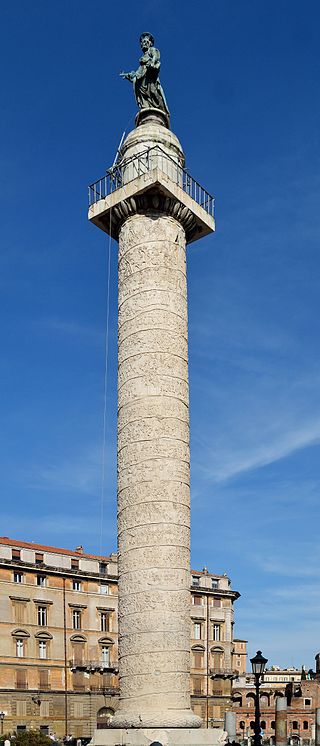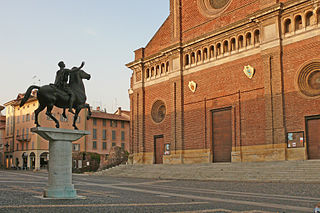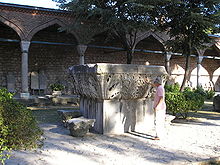
Marcian was Roman emperor of the East from 450 to 457. Very little of his life before becoming emperor is known, other than that he was a domesticus who served under the commanders Ardabur and his son Aspar for fifteen years. After the death of Emperor Theodosius II on 28 July 450, Marcian was made a candidate for the throne by Aspar, who held much influence because of his military power. After a month of negotiations Pulcheria, Theodosius' sister, agreed to marry Marcian. Zeno, a military leader whose influence was similar to Aspar's, may have been involved in these negotiations, as he was given the high-ranking court title of patrician upon Marcian's accession. Marcian was elected and inaugurated on 25 August 450.

Leo I, also known as "the Thracian", was Roman emperor of the East from 457 to 474. He was a native of Dacia Aureliana near historic Thrace. He is sometimes surnamed with the epithet "the Great", probably to distinguish him from his young grandson and co-augustus Leo II.

The Colossus of Rhodes was a statue of the Greek sun god Helios, erected in the city of Rhodes, on the Greek island of the same name, by Chares of Lindos in 280 BC. One of the Seven Wonders of the Ancient World, it was constructed to celebrate the successful defence of Rhodes city against an attack by Demetrius I of Macedon, who had besieged it for a year with a large army and navy.

Trajan's Column is a Roman triumphal column in Rome, Italy, that commemorates Roman emperor Trajan's victory in the Dacian Wars. It was probably constructed under the supervision of the architect Apollodorus of Damascus at the order of the Roman Senate. It is located in Trajan's Forum, north of the Roman Forum. Completed in AD 113, the freestanding column is most famous for its spiral bas relief, which depicts the wars between the Romans and Dacians. Its design has inspired numerous victory columns, both ancient and modern.

Aelia Pulcheria was an Eastern Roman empress who advised her brother, the emperor Theodosius II, during his minority and then became wife to emperor Marcian from November 450 to her death in 453.

Aelia Verina was the Empress consort of Leo I of the Eastern Roman Empire. She was a sister of Basiliscus. Her daughter Ariadne was Empress consort of first Zeno and then Anastasius I. Verina was the maternal grandmother of Leo II.

The Hippodrome of Constantinople, was a circus that was the sporting and social centre of Constantinople, capital of the Byzantine Empire. Today it is a square in Istanbul, Turkey, known as Sultanahmet Square.

A victory column, or monumental column or triumphal column, is a monument in the form of a column, erected in memory of a victorious battle, war, or revolution. The column typically stands on a base and is crowned with a victory symbol, such as a statue. The statue may represent the goddess Victoria; in Germany, the female embodiment of the nation, Germania; in the United States either the female embodiment of the nation Liberty or Columbia; in the United Kingdom, the female embodiment Britannia, an eagle, or a war hero.

The Colossus of Barletta is a large bronze statue of a Roman emperor, nearly three times life size, in Barletta, Apulia, Italy. It is a Late Antique statue, but the date, identity of the emperor, and the original location of the statue remain uncertain. Most datings are to the 5th or early 6th centuries, and many think it was made in Constantinople, and perhaps originally placed there. It is the largest Roman or Byzantine bronze statue to have survived essentially intact.

The Arch of Septimius Severus at the northwestern end of the Roman Forum is a white marble triumphal arch dedicated in 203 AD to commemorate the Parthian victories of Emperor Septimius Severus and his two sons, Caracalla and Geta, in the two campaigns against the Parthians of 194-195 and 197–199. After the death of Septimius Severus, his sons Caracalla and Geta were initially joint Emperors. Caracalla had Geta assassinated in Rome; in the practice now known as damnatio memoriae, Geta's memorials were destroyed and all images or mentions of him were removed from street buildings and monuments. Accordingly, Geta's image and inscriptions referring to him were removed from the arch.

The Theodosian dynasty was a Roman imperial family that produced five Roman emperors during Late Antiquity, reigning over the Roman Empire from 379 to 457. The dynasty's patriarch was Theodosius the Elder, whose son Theodosius the Great was made Roman emperor in 379. Theodosius's two sons both became emperors, while his daughter married Constantius III, producing a daughter that became an empress and a son also became emperor. The dynasty of Theodosius married into, and reigned concurrently with, the ruling Valentinianic dynasty, and was succeeded by the Leonid dynasty with the accession of Leo the Great.

The Leonid dynasty or Thracian dynasty produced six Roman emperors during Late Antiquity, reigning over the Roman Empire from 457 to 518. The dynasty's patriarch was Leo I, who was made Roman emperor in 457. Leo's daughter Ariadne became empress and mother to an emperor, and her two husbands were themselves each made emperor in turn. Another relative whose name does not survive of Leo I or his wife Verina married the future augustus Julius Nepos, the last emperor in the Western Roman Empire. The dynasty of Leo succeeded the preceding Valentinianic dynasty and Theodosian dynasty whose family trees were conjoined and ruled concurrently. Besides Julius Nepos, who administered no more than a rump state the Roman province of Dalmatia in the western empire during the fall of the west, the dynasty's emperors governed the eastern empire.
Chrysaphius was a eunuch in the Eastern Roman court who became the chief minister of Theodosius II. Having a great influence on the rule of the empire during his ascendancy, he pursued a policy of appeasement towards the Huns, which cost the empire far more gold than any military campaign, while amassing a vast fortune in bribes himself. He is depicted as a sinister figure in all the ancient accounts.

Aelia Ariadne was Eastern Roman empress as the wife of Zeno and Anastasius I. She is venerated as a saint in the Eastern Orthodox Church, with her feast day falling on August 22.

The Column of Constantine is a monumental column commemorating the dedication of Constantinople by Roman emperor Constantine the Great on 11 May 330 AD. Completed c. 328 AD, it is the oldest Constantinian monument to survive in Istanbul. The column stood in the centre of the Forum of Constantine, on the second-highest of the seven hills of Nova Roma, and was midway along the Mese odos, the ancient city's main thoroughfare.

The Column of Justinian was a Roman triumphal column erected in Constantinople by the Byzantine emperor Justinian I in honour of his victories in 543. It stood in the western side of the great square of the Augustaeum, between the Hagia Sophia and the Great Palace, and survived until 1509, its demolition by the Great earthquake of Constantinople which affected other historical places as well.

The AqueductofValens was a Roman aqueduct system built in the late 4th century AD, to supply Constantinople – the capital of the Eastern Roman Empire. Construction of the aqueduct began during the reign of the Roman emperor Constantius II and was completed in 373 by the Emperor Valens. The aqueduct remained in use for many centuries. It was extended and maintained by the Byzantines and the Ottomans.
The Palace of Antiochos was an early 5th-century palace in the Byzantine capital, Constantinople. It has been identified with a palatial structure excavated in the 1940s and 1950s close to the Hippodrome of Constantinople, some of whose remains are still visible today. In the 7th century, a part of the palace was converted into the church–more properly a martyrion, a martyr's shrine–of St Euphemia in the Hippodrome, which survived until the Palaiologan period.
The Column of Arcadius was a Roman triumphal column in the forum of Arcadius in Constantinople built in the early 5th century AD. The marble column was historiated with a spiralling frieze of reliefs on its shaft and supported a colossal statue of the emperor, probably made of bronze, which fell down in 740. Its summit was accessible by an internal spiral staircase. Only its massive masonry base survives.

The Regisole was a bronze classical or Late Antique equestrian monument, highly influential during the Italian Renaissance. It was originally erected at Ravenna, in what is now Italy, but was moved to Pavia in the Middle Ages, where it stood on a column before the cathedral, as an emblem of communal pride and Pavia's deep connection with imperial Rome.
























